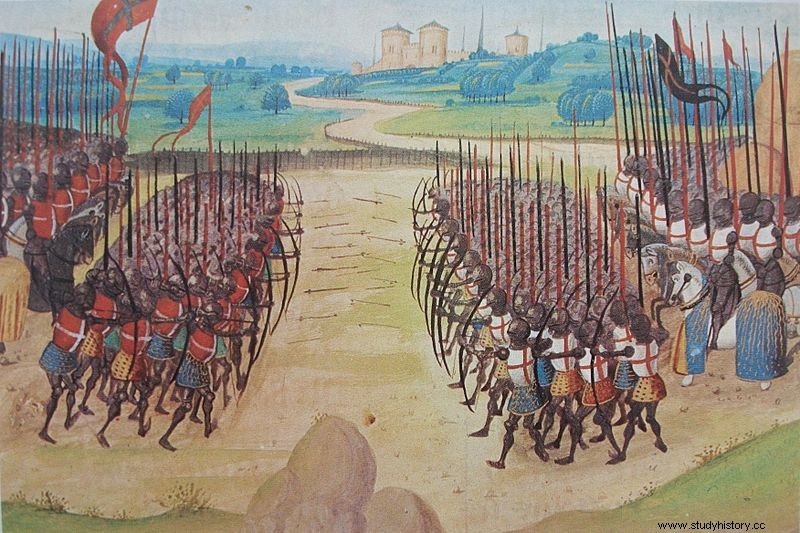The death of Charles IV le Bel (king of France), the last Capetian king, engendered a conflict of succession between Philippe VI of Valois (king of France), and Edward III of Plantagenêt (England), which triggered the Hundred Years War.
1337-1453

Characters
Charles V, the Wise
Charles VI
Charles VII
Edward III of Plantagenet
Edward Woodstock, the black prince
John II, known as John the Good
Joan of Arc
John of Lancaster, Duke of Bedford
Henry V of Lancaster
John Without Fear
Duke Charles of Orléans
Philip VI of Valois
Procedure
To calm the rebellion led by Edward III, Philip VI confiscated Aquitaine, an English stronghold since 1259, on May 24, 1337. The sea battle off the port of l'Écluse (Netherlands) which took place between the French and the English, marks the first major defeat of the French in 1340 (Battle of the Lock). The English then begin a great ride through France, plundering everything in their path. The invaded react but the battle which takes place in Crécy (Somme) is again favorable to the formidable English archers (August 26, 1346). Edward III had a string of victories, notably at Calais (1346), and took the new king Jean le Bon (Philip VI having expired) prisoner at Poitiers (1356) thanks to his son the Black Prince.
Charles V, the son of Jean le Bon, organizes the resistance. He concluded with the English the Treaty of Brétigny in 1360. The latter plans to cede a large part of the kingdom of France to the English. The French remain sovereign of France over the rest of the country. Following the death of Jean Le Bon, Charles V became king and consolidated the kingdom, as did his son Charles VI, who succeeded him on his death. But the wars internal to the kingdom which oppose the Armagnacs (Duke of Orléans) to the Burgundians (Jean sans Peur) weaken France. Henry V of Lancaster (new King of England who overthrew Richard II) then triumphed in 1415 in Agincourt thanks to the archers and their famous longbows (bows).
Northern France submitted to the Duke of Bedford, the regent of Henry VI who was to become king following the death of Henry V. Thus, the Treaty of Troyes signed by the English and the French in 1420 provided that the future king English Henry VI, on the death of the French king Charles VI, becomes "king of France and England". From then on, the Dauphin Charles VII was disinherited...
The latter was entrenched in Chinon, south of the Loire, when Joan of Arc came to meet him in February 1429. She called for an army to take back Orléans, which had been besieged since November 12, 1428. In May 1429, Jeanne la Pucelle freed the town. This victory begins the reconquest of France.
Charles VII was crowned in Reims two months later, on July 17, 1429. In 1431, after falling into the hands of the English, Joan of Arc was burned alive while the French gradually regained their territory. The Treaty of Arras puts an end to the fight between Armagnac and Burgundians. In 1445, Charles VII reformed the army, and, on May 26, 1445, created ordinance companies. This is the king's standing army. These units will largely contribute to the French victory. Indeed, eight years later, Castillon's victory in 1453 against the English marked the resumption of Aquitaine by France and above all put an end to the conflict, where it had begun...
Consequences
The War which opposed two countries for 116 years gave rise to a strong national feeling. Thus, the English who spoke French at Court now use English (and no longer the “enemy” language). In France, the creation of the permanent royal army announces the birth of the absolute power of the king. The demographic losses following the War and the Black Death lead to a decline in the West, favoring the development of international trade. This Hundred Years War is one of the most significant conflicts of the Middle Ages.
